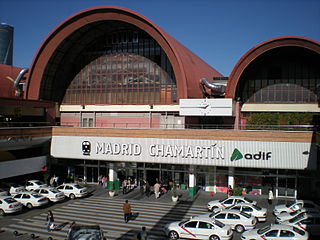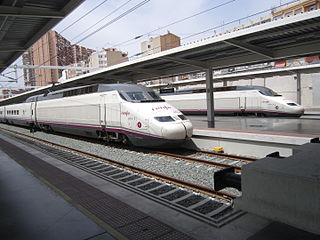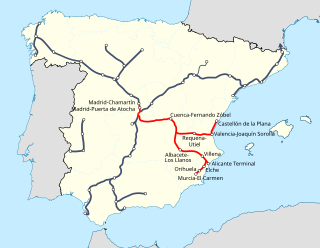
Transport in Spain is characterised by a network of roads, railways, trams, air routes, and ports. Its geographic location makes it an important link between Europe, Africa, and the Americas. Major forms of transit generally radiate from the capital, Madrid, located in the centre of the country, to link with the capitals of the autonomous communities.

Renfe Cercanías AM, formerly known as Renfe Feve, is a division of state-owned Spanish railway company Renfe Operadora. It operates most of Spain's 1,250 km (777 mi) of metre-gauge railway. This division of Renfe was previously a stand-alone company named FEVE. On 31 December 2012, the Spanish government simplified the organization of state-owned railway companies by merging FEVE into Renfe and Adif. The rolling stock and the brand FEVE were transferred to Renfe, while the infrastructure was transferred to Adif.

Renfe, officially Renfe-Operadora, is Spain's national state-owned railway company.

Rail transport in Spain operates on four rail gauges and services are operated by a variety of private and public operators. Total railway length in 2020 was 15,489 km. The Spanish high-speed rail network is the longest HSR network in Europe with 3,966 km and the second longest in the world, after China's.

Alta Velocidad Española (AVE) is a high-speed rail service operated by Renfe, the Spanish State railway company.

The Estación de Madrid-Chamartín Clara Campoamor or Madrid Chamartín is the second major railway station in Madrid, Spain. Located on the northern side of the city, it was built between 1970 and 1975, but more work was carried on into the early 1980s. It then superseded Atocha station, which is located just south of the city centre. However, as the AVE network expanded with a hub at Atocha, Chamartin again became Madrid's second station by passenger volume.

High-speed railways in Spain have been in operation since 1992 when the first line was opened connecting the cities of Madrid, Córdoba and Seville. Unlike the rest of the Iberian broad gauge network, the Spanish High-speed network mainly uses standard gauge. This permits direct connections to outside Spain through the link to the French network at the Perthus Tunnel. High-speed trains run on a network of high-speed rail track owned and managed by ADIF, where the dominant service is AVE while other high speed services such as Avant, Alvia, Avlo, Euromed, Ouigo España and Iryo, as well as mid-speed (Altaria) services also operate.

The history of rail transport in Spain begins in the 19th century. In 1848, a railway line between Barcelona and Mataró was inaugurated, although a line in Cuba connecting Havana and Bejucal had already opened in 1837. In 1852 the first narrow gauge line was built, in 1863 a line reached the Portuguese border. By 1864 the Madrid-Irun line had been opened, and the French border reached.

Alicante Terminal is the central railway station of Alicante, Spain. Commonly referred locally as the RENFE station, the station is part of Adif system, and is a terminal station.

The Renfe 334 is a high speed, 4 axle diesel-electric locomotive built to haul passenger trains on Renfe's Talgo service on non electrified lines.

Cercanías Murcia/Alicante is a commuter rail service (cercanías) in the provinces of Alicante and Murcia. The line connects Alicante and Murcia with San Vicente del Raspeig, Elche, Orihuela, Totana, Lorca, and Águilas. It runs through 200 km of railways with a total of 26 stations.

ADIF is a Spanish state-owned railway infrastructure manager. This state owned company reports to the Ministry of Transport and Sustainable Mobility. ADIF is charged with the management of most of Spain's railway infrastructure, that is the track, signaling and stations. It was formed in 2005 in response to European Union requirements to separate the natural monopoly of infrastructure management from the competitive operations of running train services. It is the legal successor of Renfe, Feve, and GIF.

The Madrid–Levante high-speed network is a network of high-speed rail lines that connects Madrid with the Mediterranean coast of the Levante Region, specifically with Castilla-La Mancha, the Valencian Community and the Murcia Region autonomous communities.
Cuenca – Fernando Zóbel Railway Station is the new railway station in Cuenca, Spain, located 5 kilometres (3.1 mi) from the city centre. The station is named after painter Fernando Zóbel to commemorate his links to the city. It occupies 3.950 square metres (42.52 sq ft) with 8.900 square metres (95.80 sq ft) of parking space. It is operated by RENFE and part of Adif and high-speed rail systems.
Traditionally, the gauge of the national railway in Spain, now managed by Adif, is 1,668 mm, known as Iberian gauge. This gauge was decided upon by a Parliamentary committee, after a report known as the Informe Subercase in 1844. Spain has 11,791 km of track with this gauge.

Murcia del Carmen railway station is the main railway station in the Spanish city of Murcia.
The Murcia–Almería high-speed rail line is an under-construction railway in the Region of Murcia and Andalusia in Spain.

The Canton of Cartagena, also known as the Canton of Murcia, was a period of Cartagena, Spain's history when it was governed by a radical cantonalist junta for six months between 1873 and 1874. The city rose up in armed insurrection on July 12, 1873 establishing the Canton's de facto independence from the First Spanish Republic and beginning a wave of cantonal rebellions across southern Spain. Loosely inspired by the more well-known Paris Commune two years earlier, the Canton of Cartagena existed during a turbulent revolutionary period of Spanish history known as the Sexenio Democrático.

Ouigo España is an open-access operator of high-speed railway services in Spain. It is a subsidiary of SNCF Voyageurs, the French national railway company, and uses its trademark Ouigo.

The Madrid, Zaragoza and Alicante railway (MZA) - also known in Spanish as Compañía de los ferrocarriles de Madrid a Zaragoza y a Alicante - was a Spanish railway company founded in 1856 that became one of the most important companies in the railway sector, along with its great rival, the Compañía de los Caminos de Hierro del Norte de España

















